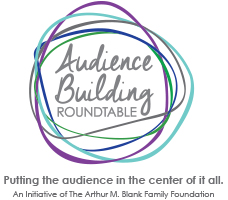True Colors Theatre
By Jamie Annarino, Audience Building Roundtable
True Colors Theatre is not unlike most arts organizations in that it strives to determine the most effective strategies to maintain audience engagement and keep ticket buyers/patrons coming back. But how does an organization know if it’s on the right track? Which marketing strategies really “move the needle” and contribute to the organization’s bottom line and which ones only have a marginal impact on patrons returning to the theatre?
In November 2016, The Arthur M. Blank Family Foundation offered the opportunity for member organizations of the Audience Building Roundtable to participate in its first “patron retention study.” The Foundation contracted with TRG Arts, a national arts and culture firm grounded in data-driven consultation, to conduct the study.
The study included a comprehensive review of transactional audience information, including each participating organization's growth in the number of households in its database of ticket buyers and subscribers; the rate of attracting new patrons (first time buyers;) the attrition of both new and existing ticket buyers (exits) and the data about same-year multi-ticket buying. Each of these metrics were studied by type (ticket buyers, members, donors, etc.), and then compared in each category to the other organizations participating in the study and to TRG's national comparison group.
The analysis included:
Buyer type trend analysis
Analysis of audience behavior for each individual organization and among the five participating organizations
Analysis of age cohorts for each organization and in the aggregate for the 5 organizations
A survey administered to non-returning ticket buyers, members, donors and subscribers to understand the reasons that they were not returning to the theatre
Analysis of marketing expenditures
True Colors Theatre was one of five organizations chosen to participate in the study. The key findings offered an opportunity for True Colors to revise its marketing approach.
True Colors’ season subscriber growth is slightly above the national average, with the lowest attrition rate among the five organizations in the study
From 2012 to 2015, True Colors Theatre’s total household ticket buyers and supporters remained steady, then experienced a decline in 2016
True Colors Theatre became more reliant on its existing households as its new household growth slowed during 2016
True Colors Theatre was losing its existing audience at a greater rate than it was acquiring new audience members (households) and its attrition rates were similar across all demographics
The organization’s expenses remained flat while its revenue was declining
The study revealed inconsistent growth in philanthropic support and a marketing expense budget with above-average marketing expenses
Translating Data into Action
Keep Em’ Coming Back
The study suggested diversifying marketing efforts to convert first-time ticket buyersinto returning patrons(multi-buyers, subscribers, and donors;) specifically, the analysis recommended using direct mail as a means of outreach.
Following True Colors’ show, King Hedley II, a targeted direct mail and email marketing campaign was implemented - aimed at the first-time ticket buyers to the seasons past three productions. True Colors Theatre mailed a simple “thank you” postcard with a stunning image from this show and included a follow up 50% discount promotional code to these single ticket buyers; the code was good for tickets to attend the upcoming show Dot, with a promotion period of 6 weeks.
The postcard mailing yielded a break-even on costs. True Colors indicates that this was probably because the follow up was sent months after the performance the ticket buyers attended; in the future, True Colors intends to implement the follow up postcard mailing within a week of the first-time ticket buyers attending a performance.
Cutting Costs
With the new season looming, True Colors is drastically reducing its subscriber renewal telemarketing budget (from $30,000 to $10,000) as well as raising adult ticket prices from $35 to $40 per show. Last season, the total subscription and single ticket sale revenue was $409,112. To date for the 2017-2018 season, revenue stands at $559,592, with one additional show on this season’s calendar. True Colors Theatre has implemented email and direct mail strategies for subscription renewals and will kick off a direct mail and email campaign to sell two- and three-show ticket-packages during July 2018. As of June 15, True Colors had sold $23,000 in subscriptions for the 2018-2019 season with four months to the start of the season.
Tracking
True Colors is using TRG’s expense projection report to determine revenue and expenses based on direct mail/email efforts. This report has been extremely helpful and is set up to track targeted promotional codes (that True Colors creates).
True Colors’ achieved 95% of its ticket sales goal for its next season by July 17, 2018. (The goal was to sell half of its tickets for the entire season by July 17.)
Another Point of View
True Colors reports that it “blew their mind” to realize the impact of “household” revenue versus “individual” revenue. This realization changed the way True Colors approaches marketing to existing audiences.
In the 2015-2016 season, revenue of $505,392 was generated by 4,079 households. In 2016-2017, True Colors’ revenue decreased by $100,000 – from 300 households. True Colors’ staff notes that “in marketing, it can get overwhelming thinking about filling 27,000 seats each year (our capacity for 3 productions). However, understanding the patron retention data helped us to realize that we’re really only dealing with 4,000 households to fill those seats.”
This season, True Colors is focusing on getting those 300 “lapsed” households back, which seems much more manageable than focusing on selling 27,000 seats.
True Colors reports that “cultivating those households when they first come to the theatre is crucial - then fostering the relationship with the household becomes easier to manage once they are more involved.”
True Colors indicates that they are better segmenting their audience as a result of the patron retention analysis, tracking the results of their marketing efforts, and using the data to work toward consistent growth of their audience.



